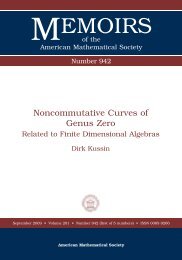University of Paderborn Department of Mathematics Diploma Thesis ...
University of Paderborn Department of Mathematics Diploma Thesis ...
University of Paderborn Department of Mathematics Diploma Thesis ...
You also want an ePaper? Increase the reach of your titles
YUMPU automatically turns print PDFs into web optimized ePapers that Google loves.
68 CHAPTER 3. OPERATIONS ON STABLE IDEALSare minimal generators <strong>of</strong> J. We already know that m is a minimal generator <strong>of</strong> J. It is clearthat x 0 , x 1 , . . . , x n−r−2 are minimal generators <strong>of</strong> J. Consider the monomial x ar+1n−r−1 ∈ J.If we assume that it is not a minimal generator <strong>of</strong> J, it follows that there is a monomialgenerator x k n−r−1 ∈ J, k ≤ a r . But then, this generator also divides m, which is a contradiction.If x arn−r−1 · x a r−1+1n−r were not a minimal generator <strong>of</strong> J, there would be a generatorx k n−r−1 · x l n−r ∈ J, k ≤ a r , l ≤ a r−1 . Again, m would also be divisible by this monomial,which is a contradiction.Iteration <strong>of</strong> this argument provides that all monomials in the above set are minimal generators.Now assume, there is a monomial generator ˜m <strong>of</strong> J, which is not contained in theabove set. Since the above set generates a lexicographic and stable ideal and ˜m cannotcontain the variable x n−1 , it follows either, that ˜m divides any <strong>of</strong> the above monomials,which contradicts the fact that they are all minimal generators, or ˜m is divisible by any<strong>of</strong> the above monomials, which is a contradiction to the fact that ˜m is assumed to be aminimal generator. Hence, J is generated by the monomials in the above set, which provesclaim 2.It follows by Theorem 2.25 that J is the unique lexicographic ideal L p associated to theHilbert polynomial p(z) (which is again associated to the Hilbert series H(t) <strong>of</strong> R/L H ).Since the expansions and contractions described in Remark 3.31, which we used to computeJ from L H , do not change the double saturation, it follows sat xn−1 ,x n(L H ) = sat xn−1 ,x n(J) =sat xn−1 ,x n(L p ).Example 3.36. Let R := K[x 0 , x 1 , x 2 , x 3 ] and H(t) = 1 − t − t2 + t 4 + t 5 − t 6. Then the(1 − t) 4unique lexicographic ideal L H , such that H R/LH (t) = H(t), is L H = (x 0 , x 2 1, x 1 x 2 2, x 4 2) andp R/LH (z) = 6. To compute L p from L H , we first we contract x 1 x 2 in L H , which provides theideal (x 0 , x 2 1, x 1 x 2 , x 4 2). Next, we contract x 1 , and obtain (x 0 , x 1 , x 4 2). Then we expand x 4 2,which provides (x 0 , x 2 1, x 5 2), and finally we obtain the ideal (x 0 , x 2 1, x 6 2) from the expansion<strong>of</strong> x 5 2. Indeed, the ideal (x 0 , x 2 1, x 6 2) equals the unique lexicographic ideal L pR/LH associatedto the Hilbert polynomial p R/LH (z).The pro<strong>of</strong> <strong>of</strong> the preceding theorem suggests a method to compute the lexicographic idealL p from the lexicographic ideal L H . Since we know by the theorem that these ideals havethe same double saturation, it follows that we can also compute L H from L p :Corollary 3.37. Let p R/I (z) be the Hilbert polynomial <strong>of</strong> R/I for some saturated stableideal I ⊂ R. Then the lexicographic ideal L H associated to any Hilbert series H(t), suchthat p R/LH (z) = p R/I (z), can be obtained from L p by a sequence <strong>of</strong> paired expansions andcontractions.Pro<strong>of</strong>. By Theorem 3.35, we know sat xn−1 ,x n(L H ) = sat xn−1 ,x n(L p ). Since p R/LH (z) =p R/Lp (z), the assertion follows from Theorem 3.32.Remark 3.38. Corollary 3.37 implies that to a given Hilbert polynomial p(z) we can findall Hilbert series associated to the Hilbert polynomial p(z) (in other words: We computeall Hilbert functions to a given Hilbert polynomial). We give the algorithm in pseudo code.
















